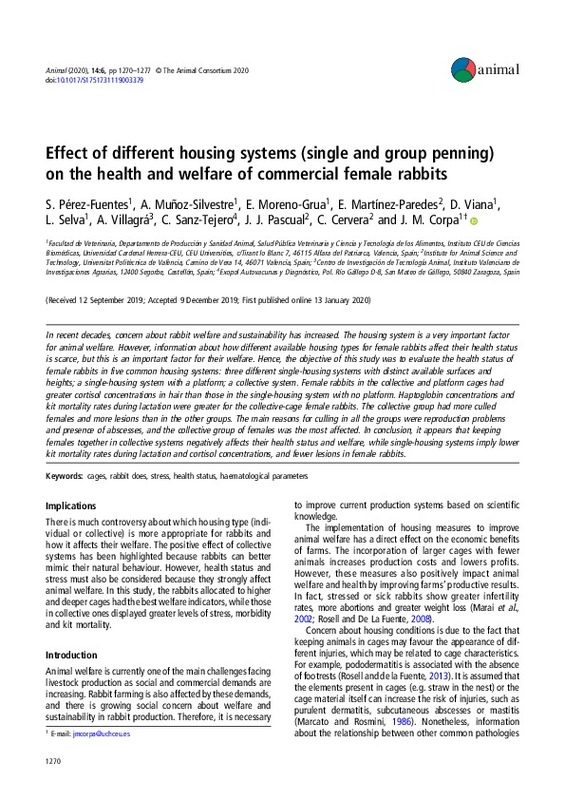Archetti I, Tittarelli C, Cerioli M, Brivio R, Grilli G and Lavazza A 2008. Serum chemistry and hematology values in commercial rabbits: preliminary data from industrial farms in northern Italy. In Proceedings of the 9th World Rabbit Congress, 10–13 June 2008, Verone, Italy, pp. 1147–1152.
Argente, M.-J., García, M. de la L., Birlanga, V., & Muelas, R. (2014). Relationship between cortisol and acute phase protein concentrations in female rabbits. The Veterinary Journal, 202(1), 172-175. doi:10.1016/j.tvjl.2014.07.020
Cervera C, Martínez-Paredes E, Machado L and Villagrá A 2017. Producción de conejas en sistemas de alojamiento individual o colectivo en semigrupo. In Proceedings of the XLII Symposium de Cunicultura de ASESCU, 11–12 May 2017, Murcia, Spain, pp. 107–110.
[+]
Archetti I, Tittarelli C, Cerioli M, Brivio R, Grilli G and Lavazza A 2008. Serum chemistry and hematology values in commercial rabbits: preliminary data from industrial farms in northern Italy. In Proceedings of the 9th World Rabbit Congress, 10–13 June 2008, Verone, Italy, pp. 1147–1152.
Argente, M.-J., García, M. de la L., Birlanga, V., & Muelas, R. (2014). Relationship between cortisol and acute phase protein concentrations in female rabbits. The Veterinary Journal, 202(1), 172-175. doi:10.1016/j.tvjl.2014.07.020
Cervera C, Martínez-Paredes E, Machado L and Villagrá A 2017. Producción de conejas en sistemas de alojamiento individual o colectivo en semigrupo. In Proceedings of the XLII Symposium de Cunicultura de ASESCU, 11–12 May 2017, Murcia, Spain, pp. 107–110.
Dal Bosco, A., Mugnai, C., Martino, M., Szendrő, Z., Mattioli, S., Cambiotti, V., … Castellini, C. (2019). Housing Rabbit Does in a Combi System with Removable Walls: Effect on Behaviour and Reproductive Performance. Animals, 9(8), 528. doi:10.3390/ani9080528
Dalle Zotte, A., Princz, Z., Matics, Z., Gerencsér, Z., Metzger, S., & Szendrő, Z. (2009). Rabbit preference for cages and pens with or without mirrors. Applied Animal Behaviour Science, 116(2-4), 273-278. doi:10.1016/j.applanim.2008.08.011
Machado L, Cervera C, Martínez-Paredes E, Paragliola F and Cano C 2016. Comportamiento y manejo de conejas en sistemas de cría colectiva. In Proceedings of the XLI Symposium de Cunicultura de ASESCU, 12–13 May 2016, Hondarribia, Spain, pp. 134–137.
Maertens L and Buijs S 2016. Impact of housing system (cage vs. part-time housing) and floor type on rabbit doe welfare. In Proceedings of the 11th World Rabbit Congress, 15–18 June 2016, Qingdao, China, pp. 707–710.
Marai, I. F. ., Habeeb, A. A. ., & Gad, A. . (2002). Rabbits’ productive, reproductive and physiological performance traits as affected by heat stress: a review. Livestock Production Science, 78(2), 71-90. doi:10.1016/s0301-6226(02)00091-x
Marcato PS and Rosmini R 1986. Mammary glands. In Pathology of the rabbit and hare (eds. PS Marcato and R Rosmini ), pp. 179–186. Società Editrice Esculapio, Bologna, Italy.
Masthoff, T., & Hoy, S. (2019). Investigations on the Influence of Floor Design on Dirtiness and Foot Pad Lesions in Growing Rabbits. Animals, 9(6), 354. doi:10.3390/ani9060354
Mugnai, C., Dal Bosco, A., & Castellini, C. (2009). Effect of different rearing systems and pre-kindling handling on behaviour and performance of rabbit does. Applied Animal Behaviour Science, 118(1-2), 91-100. doi:10.1016/j.applanim.2009.02.007
Petersen, H. H., Nielsen, J. P., & Heegaard, P. M. H. (2004). Application of acute phase protein measurements
in veterinary clinical chemistry. Veterinary Research, 35(2), 163-187. doi:10.1051/vetres:2004002
Rödel, H. G., Starkloff, A., Bautista, A., Friedrich, A.-C., & Von Holst, D. (2008). Infanticide and Maternal Offspring Defence in European Rabbits under Natural Breeding Conditions. Ethology, 114(1), 22-31. doi:10.1111/j.1439-0310.2007.01447.x
Rödel, H. G., Starkloff, A., Seltmann, M. W., Prager, G., & von Holst, D. (2009). Causes and predictors of nest mortality in a European rabbit population. Mammalian Biology, 74(3), 198-209. doi:10.1016/j.mambio.2008.04.003
Rommers, J. M., Boiti, C., De Jong, I., & Brecchia, G. (2006). Performance and behaviour of rabbit does in a group-housing system with natural mating or artificial insemination. Reproduction Nutrition Development, 46(6), 677-687. doi:10.1051/rnd:2006038
Rommers, J., & De Greef, K. H. (2018). Are combi parks just as useful as regular parks for fatteners for part-time group housing of rabbit does? World Rabbit Science, 26(4), 299. doi:10.4995/wrs.2018.9587
Rosell J and De La Fuente L 2008. Health and body condition of rabbit does on commercial farms. In Proceedings of the 9th World Rabbit Congress, 10–13 June 2008, Verone, Italy, pp. 1065–1069.
Rosell, J., & de la Fuente, L. (2013). Assessing Ulcerative Pododermatitis of Breeding Rabbits. Animals, 3(2), 318-326. doi:10.3390/ani3020318
Sánchez, J. P., de la Fuente, L. F., & Rosell, J. M. (2012). Health and body condition of lactating females on rabbit farms1. Journal of Animal Science, 90(7), 2353-2361. doi:10.2527/jas.2011-4065
Segura, P., Martinez, J., Peris, B., Selva, L., Viana, D., Penades, J. R., & Corpa, J. M. (2007). Staphylococcal infections in rabbit does on two industrial farms. Veterinary Record, 160(25), 869-872. doi:10.1136/vr.160.25.869
Siemsen DW, Malachowa N, Schepetkin IA, Whitney AR, Kirpotina LN, Lei B, DeLeo FR and Quinn MT 2014. Neutrophil isolation from nonhuman species. In Neutrophil methods and protocols (eds. MT Quinn and FR De Leo ), pp. 19–37. Humana Press, Totowa, NJ, USA
Szendrő, Z., & McNitt, J. I. (2012). Housing of rabbit does: Group and individual systems: A review. Livestock Science, 150(1-3), 1-10. doi:10.1016/j.livsci.2012.09.017
Szendrő, Z., Mikó, A., Odermatt, M., Gerencsér, Z., Radnai, I., Dezséry, B., … Matics, Z. (2013). Comparison of performance and welfare of single-caged and group-housed rabbit does. Animal, 7(3), 463-468. doi:10.1017/s1751731112001760
Szendrő, Z., Trocino, A., Hoy, S., Xiccato, G., Villagrá, A., & Maertens, L. (2019). A review of recent research outcomes on the housing of farmed domestic rabbits: reproducing does. World Rabbit Science, 27(1), 1. doi:10.4995/wrs.2019.10599
Tallo-Parra, O., Manteca, X., Sabes-Alsina, M., Carbajal, A., & Lopez-Bejar, M. (2015). Hair cortisol detection in dairy cattle by using EIA: protocol validation and correlation with faecal cortisol metabolites. Animal, 9(6), 1059-1064. doi:10.1017/s1751731115000294
Viana, D., Selva, L., Segura, P., Penadés, J. R., & Corpa, J. M. (2007). Genotypic characterization of Staphylococcus aureus strains isolated from rabbit lesions. Veterinary Microbiology, 121(3-4), 288-298. doi:10.1016/j.vetmic.2006.12.003
Zomeño, C., Birolo, M., Gratta, F., Zuffellato, A., Xiccato, G., & Trocino, A. (2018). Effects of group housing system, pen floor type, and lactation management on performance and behaviour in rabbit does. Applied Animal Behaviour Science, 203, 55-63. doi:10.1016/j.applanim.2018.03.002
[-]









